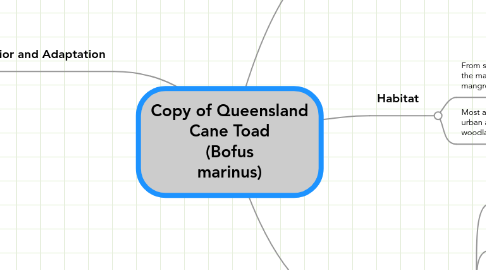Copy of Queensland Cane Toad (Bofus marinus)
by lius eva

1. History
1.1. Roughly 101 cane toads were introduced from Hawaii to Australia in 1935
1.1.1. Arrived in Edmonton
1.1.2. To control sugar cane pest
1.2. Breeding occured almost immediately
1.2.1. Females lay 8,000 to 35,000 eggs at a time and may produce two clutches a year.
1.2.2. 60,000 young toads released from the 101 after 6 months
2. Behavior and Adaptation
2.1. Tolarate a broad range of environmental and climatic conditions and appear to be able to adjust and survive in any habitat system
2.1.1. They can survive the loss of up to 50% of their body water, and can survive temperatures ranging from 5ºC - 40ºC.
2.2. Cane Toad eggs, tadpoles, metamorphlings and adults are highly toxic to vertebrate predator
2.3. Adult Cane Toads are active at night during the warm months of the year.
3. Identification
3.1. Dry warty skin.
3.2. May be grey, yellowish, olive-brown or reddish-brown.
3.3. Average-sized adults are 10-15 cm long.
3.4. Male Cane Toads are smaller and wartier than females.
3.5. Young Cane Toads have a smooth dark skin with darker blotches and bars, and lack conspicuous parotoid glands.
3.6. Cane Toad tadpoles are shiny black on top and have a plain dark belly and a short thin tail
4. Habitat
4.1. From sand dunes and coastal heath to the margins of rainforest and mangroves.
4.2. Most abundant in open clearings in urban areas, and in grassland and woodland.


